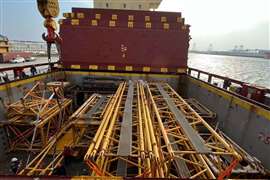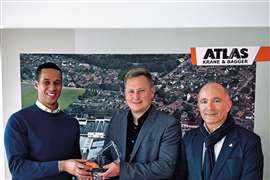Doosan CEO Tony Helsham: 'rental is inevitable'
14 August 2013

Murray Pollok asks Tony Helsham, CEO of Doosan Infracore Construction Equipment, about the lure of the rental market, and the dangers.
Tony Helsham has more of an insight into rental than many construction equipment CEOs: he was boss of Volvo CE when it launched its own Volvo Rents operation. That experience hasn’t dented his belief that equipment rental is here to stay, but it’s not a strategy he wants to repeat now that he is leading Doosan Infracore’s construction equipment business.
“The kind of work you have to do – safety training, operator training – it’s an enormous amount of back office work”, he tells IRN during an one-to-one interview at Bauma, “It was totally underestimated by us at Volvo. I would never do it again, and Doosan would never do it.”
The CEO of Doosan Infracore Construction Equipment since April 2010, Mr Helsham views the rental sector both as a major customer for its products and an important business for its Bobcat dealers, particularly in the US, whose own rental operations represent “a huge business in itself.”
“With a strong brand like Bobcat rental is not such a bad business to be in, which is quite an eye-opener for me”, he says. Doosan bought Bobcat from Ingersoll Rand in 2007 for US$4.9 billion, giving it a range of compact equipment and Ingersoll Rand’s portable power business (including compressors and generators), plus an inroad to the rental sector.
If Doosan and Bobcat have no interest in developing an OEM-owned rental business, there is definitely a dealer-led focus on rental with Bobcat – a bit like the Cat Rental Stores but with a slightly different approach.
“We have, everywhere in North America, a very clear dealer identity programme. It’s like Harley Davidson stories – they have a look, a smell and a feel”, says Mr Helsham, “You drive past a Harley Davidson store and you know what it is.
“We want to have, and do have, a similar thing with our dealers: Bobcat of Louisville, Bobcat of Cincinnati, with the same corporate look and feel. And part of that corporate identity is to have their own dealer rental fleet.
“Do we need to control it and do they need to call it Bobcat Rental? No, it’s not necessary. Our dealers [in North America] have been renting for a long, long time – customers know they can walk in there and rent a machine.”
Mr Helsham, an Australian with an informal style - he apologises if he sometimes appears “flippant” - says he now wants Bobcat’s dealers in Europe to try to replicate that model, although the approach will differ country by country, depending on the maturity of the local independent rental sector.
In the wider context, he says Bobcat’s experience is helping Doosan target rental. “Rental companies are moving up the size class, and frankly, with Doosan we have the opposite situation that we have with Bobcat – we are trying to break into the rental market, competing against the John Deeres and Komatsus of the world, and we’re playing second fiddle.
“Until we bought Bobcat, and had Bobcat’s experience of rental to bring to the table, [Doosan] had no clue. And rental companies would not buy from a Korean company – why would they?
“Bobcat has brought the knowledge and the relationships with rental companies, and we are starting to gently penetrate the rental houses. Not with huge volumes of equipment, but orders of five or six, two or three machines. Because of the Bobcat relationships they are saying, ‘OK, I’ll try it out – I’m not going to give you all our business, but I’ll give it a start.’ We’d never have been able to do that without Bobcat.”
This focus on rental reflects the general increase in rental penetration in the world’s developed markets. “I have felt for the last 25 years that rental is inevitable”, says Mr Helsham, “And clearly we have evidence to prove that when times are good people purchase, especially in years gone by, and as we go through the business cycle and they get to the bottom of the cycle, and get rid of their equipment, we all know that before they even consider buying again, they will rent.”
The growth of rental presents challenges to manufacturers, with large rental companies proving tough negotiators and sometimes wishing to bypass the dealers, doing business directly with the OEMs.
Mr Helsham is generous in his portrayal of rental companies as professional partners, and says they are little different from major contractor customers – keen to negotiate a good price, but generally understanding of the challenges being faced by manufacturers.
Where rental companies want to deal direct with Doosan it will do so, he says, with dealers given a commission if a rental sale is in their territory.
Does he fear for the future of dealers, particularly in a compact equipment market increasingly dominated by rental? “Is the UK the ‘worst case’ example [of a fully developed rental market]? It probably is. Are Bobcat’s dealers doing well in the UK? Yes. Are they coexisting with rental companies? Yes.
“Exactly what combination there will be [of OEMs, dealers, rental companies], I don’t know. Not all rental companies have their own service facilities at every branch, so there will always be a need for dealers.”
Rental companies do have particular demands, however, such as extended payment terms and even rental split agreements. Mr Helsham says Doosan is willing to have a line of credit for good rental customers. On rental split deals he is more cautious; “We do that, but I’m only in favour of it if we are introducing a new product or line and the rental company wants you to share in the risk.
“So, for example, breaking into rental with Doosan’s products; in a number of cases that was a rental split. But we wouldn’t do that with Bobcat.”
Still, Mr Helsham isn’t happy with Bobcat’s share of the European market; “We need to do more with rental companies in Europe…competition in Europe is a lot more than in North America, especially in mini-excavators, that’s the challenge.”
What is the strategy? “We’re not going to do it on price. We either have to figure out how to take out cost on our products, so that we can still make a decent margin, or some other way to make it.
“We want to increase our exposure or volume to the rental industry, because it is a great way of getting the brand out there, of getting bums on seats, and perhaps leading to a sale.”
With acquisitions off the agenda following the massive Bobcat deal in 2007 and the 2009 Moxy acquisitions, Doosan is focusing on operational matters, with reducing costs a key priority. “We have targets…we want to cut our costs by 2 to 3% every year, which is very challenging. And it’s not always achievable, especially with material prices.”
The presence of Chinese manufacturers is another complicating factor. “How many more players can this market absorb?”, he says, gesturing to the Bauma showground outside the Doosan stand, “And what damage are the Chinese going to do? I say damage – right now they are being very disciplined with their pricing.
“If they decide to do what the Japanese did in the 70s and 80s, or the Koreans in the 80s, and drop the prices when times are tough because they want to optimise their production system and keep employment up, the world market is going to be devastated.”
They haven’t done so yet; “I would like to think that they have learned and become disciplined”, says Mr Helsham, “So far so good”.
Doosan is forecasting only slight growth overall this year – he says the global economy “isn’t out of the woods yet” - with China being a big reason for the neutral assessment; “We are dependent for quite a significant amount on China, and although we think it’s bottomed out, we don’t see enormous growth there.”
“[China] has announced infrastructure spending, but they’ve not got the money. The financing rests with the provinces and the provinces don’t have the money”, he says, “We are seeing some orders come in for China, but this is the peak season. A few years ago we were getting orders for 4000 excavators a month; we’re not getting anything like that now. Tell me where else you’re getting 4000 orders in a month?”
Rental-wise, it was North America where the company saw a “big bang” in orders last year, but this year has got off to a slower start; “The financial year is coming to an end, so big rental companies don’t want to load their balance sheets before they deliver their end of year results. We have quite a number of orders on hand with rental companies where they have said ‘don’t ship yet’, which is good and bad, because we built the equipment and have to carry it. It’s part of the challenge.”
Europe has been more difficult, with the first quarter seeing fewer than anticipated mini-excavator orders from rental companies, although that has been offset by more buoyant activity with private contractors.
“We expect rental companies in Europe to start buying towards the third quarter of this year”, he says, although admits that he sees little strong evidence of substantial growth, “I guess we’re slightly optimistic about the market.”
Having said that, he expresses some bemusement about the atmosphere at Bauma; “I look around the show, and the orders were taking on the stand, and it surprises me, shocks me actually. The optimism that’s here, from Europeans, I still don’t understand why.”
What he does understand is the challenges of running a rental company; “It’s a very complicated business to run, and these guys are very successful at it. Sourcing, fleet utilisation, dollar utilisation, when to trade in and when to keep, and frankly, they are better at predicting economic upturns than anybody else.
“In North America we started getting signals from rental as early as the first half of 2011”, he recalls, “Can you imagine us then, in early 2011, thinking that North America was going to improve, and then we got an order from a rental company for 600 skid steers. That’s pretty gutsy.”



